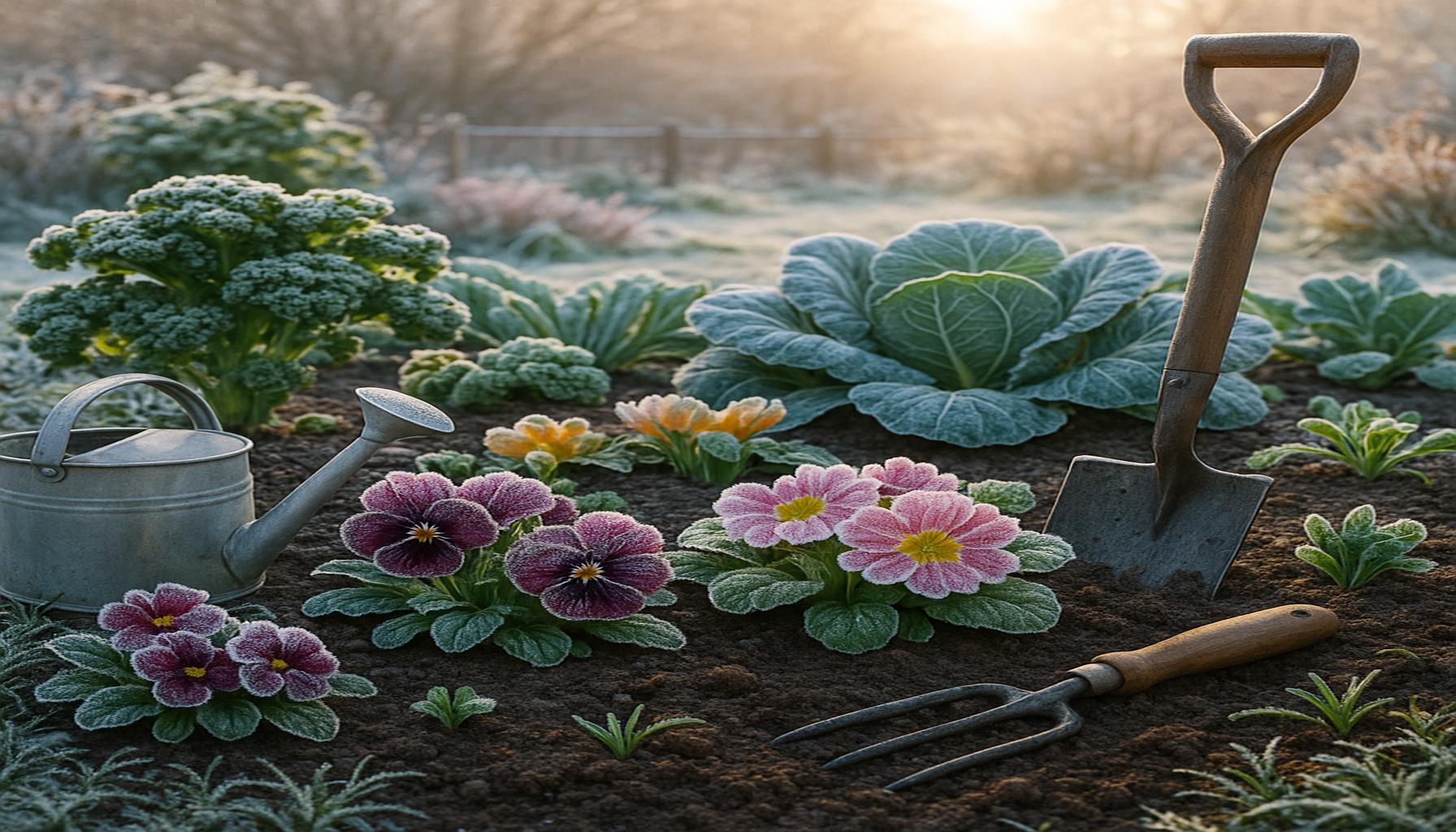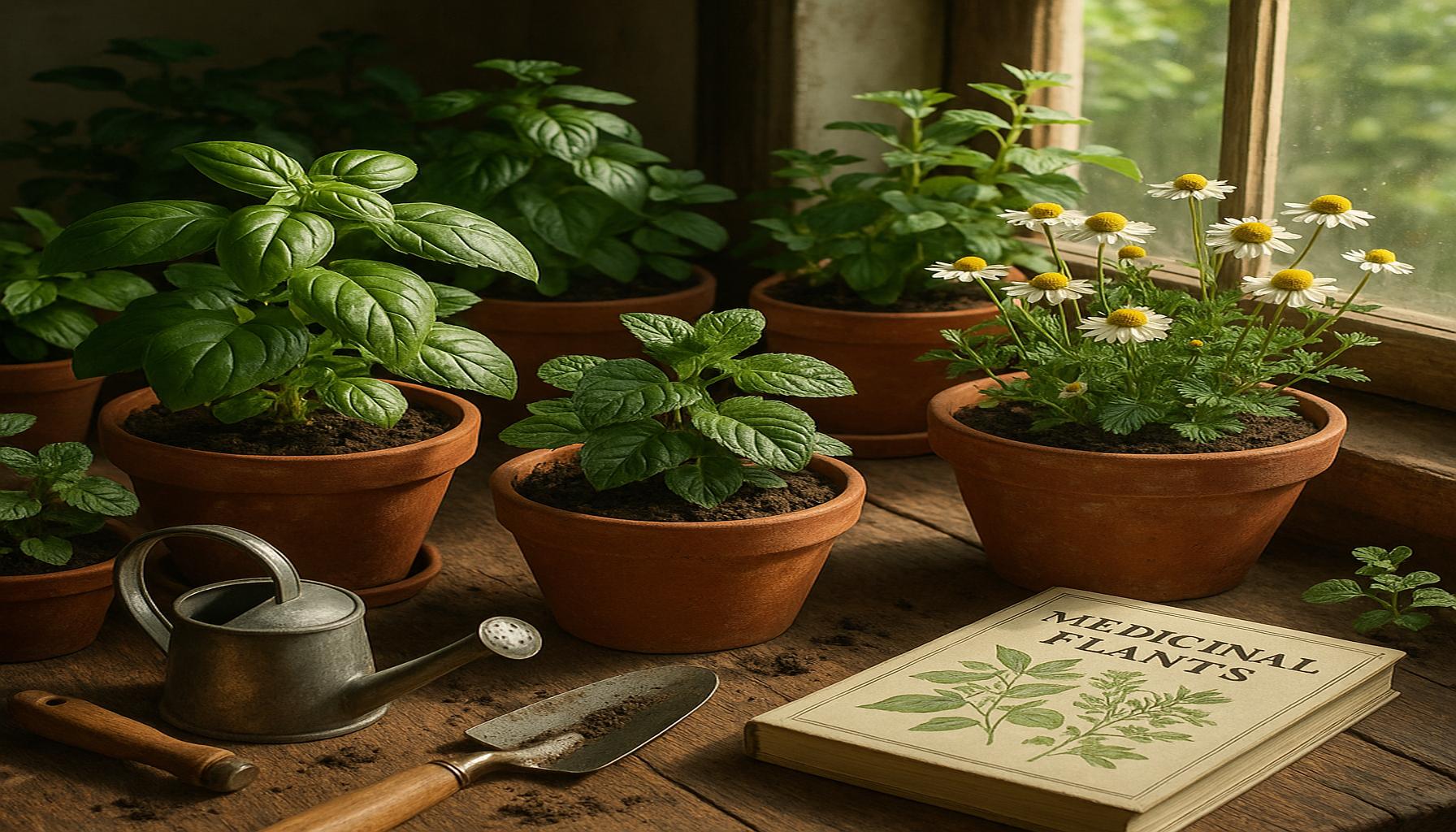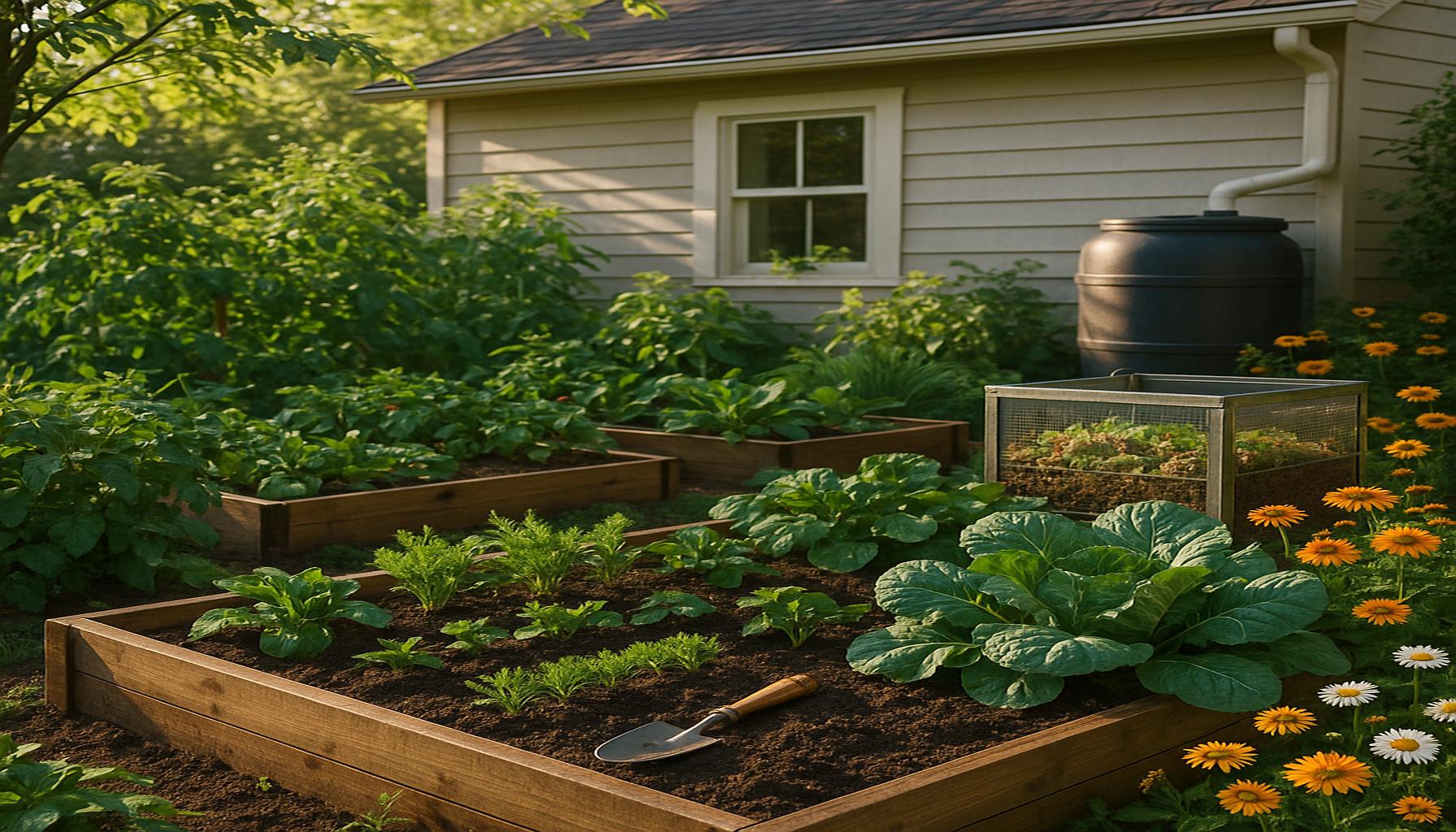Winter Gardening: How to Keep Your Garden Vibrant During the Cold Months

Embracing the Chill: A Guide to Winter Gardening
As the temperatures drop and snow starts to blanket your garden, it’s easy to think that gardening must come to a halt. However, winter gardening offers a unique opportunity to keep your landscape thriving even in the coldest months. Just because the growing season has shifted does not mean your gardening passion should wither away. Instead, with a few strategic choices and some mindful planning, you can transform your winter garden into a landscape brimming with life and color.
One of the first steps in winter gardening is to choose hardy plants. Varieties such as kale, pansies, and hellebores stand resilient even when temperatures plummet. For instance, kale thrives in the cold, offering added nutritional value while also providing textural interest to your beds. Pansies, with their vibrant colors, can flourish in the winter months, creating a cheerful display cut through the gloom of grey days. Hellebores, often called the Christmas rose, are among the first flowers to bloom—they often emerge even when snow is still on the ground, proving that beauty can indeed bloom through adversity.
Next, consider employing protective covers to shield delicate plants from harsh elements. Row covers are an excellent resource, providing a greenhouse effect that warms the plants underneath while still allowing light and moisture to reach them. Built structures like greenhouses or cold frames can further enhance your gardening potential, enabling you to cultivate tender crops like herbs or certain vegetables throughout the winter months.
Additionally, it’s important to plan for color in your winter garden. Beyond the hardy plants mentioned, incorporating evergreens such as boxwood or holly can provide year-round structure and color, while winter-blooming flowers like witch hazel add fragrant interest. This combination not only maintains the visual appeal of your garden but also offers habitats for local wildlife, supporting biodiversity even in colder conditions.
Winter gardening may also involve exciting techniques that are not only practical but refreshing. Implementing mulching effectively can help conserve soil warmth, promoting a healthier root system. Regular winter care tasks, such as checking moisture levels and protecting plants from heavy snowfall, will keep your garden vibrant. Engaging in these routines can also serve as a soothing winter hobby, keeping you connected to your passion even during the off-season.
As you delve into the world of winter gardening, you’ll find that this season offers a different yet rewarding kind of cultivation. By adopting these strategies, from selecting the right plants to employing protective measures, you’ll not only preserve the beauty of your landscape but also enhance your appreciation for gardening year-round. Explore the different winter gardening practices, and you just might discover a new and fulfilling dimension to your horticultural journey.
DISCOVER MORE: Click here to learn about the future of creativity
Winter Plant Selection: Your Garden’s Resilience
Choosing the right plants is fundamental to achieving a vibrant winter garden. By focusing on hardy varieties, gardeners can cultivate a landscape that resists the harsh elements of winter while still providing visual interest. Some of the best options are those that naturally thrive in cooler temperatures and can withstand frost. Here are a few hardy plant selections that can help maintain the beauty of your winter garden:
- Kale: Not only does kale survive the cold, but its flavor sweetens with lower temperatures, making it both a nutritious and decorative addition.
- Pansies: These cheerful flowers are perfect for brightening up a snowy landscape. Their vibrant colors can endure and even flourish when temperatures dip.
- Hellebores: Known as the “Christmas rose,” these unique flowers typically bloom in late winter, showcasing delicate blossoms that can withstand frost and snow.
- Winter Jasmine: This hardy shrub produces yellow flowers that bloom as early as January and can brighten up the dreariest of winter days.
- Snowdrop: With its snowy-white blooms, this bulbous perennial often pushes through the snow, marking the end of winter and the approach of spring.
Moreover, winter gardening isn’t just about surviving the cold; it’s about creating life in the midst of dormancy. Certain plants even provide essential nutrition during the cold months, such as root vegetables like carrots and beets, which can be harvested throughout winter if mulched properly. For those looking to maintain a productive garden, cold-hardy herbs like thyme, oregano, and even parsley can add fresh flavors to winter meals.
Utilizing Protective Techniques
To go a step further in your winter garden endeavors, consider the implementation of protective covers. These techniques can be essential for fostering the growth of delicate plants. For instance:
- Row Covers: These lightweight fabrics can be placed over plants to protect them from cold winds and extreme temperatures while still allowing sunlight and moisture to penetrate.
- Cold Frames: A cold frame acts as a mini-greenhouse, providing a warm environment for your plants. They are perfect for germinating seeds or nurturing young seedlings throughout the winter months.
- Mulching: Applying a thick layer of organic mulch around your plants can help insulate the soil, retain moisture, and protect the root systems from freezing temperatures.
Engaging in these protective techniques not only serves to safeguard your plants but also invites a winter wonderland aesthetic into your garden. The interplay of textures from hardy foliage, snowy blankets, and vibrant hues can create a magical setting that transforms the typically barren landscape of winter into an inviting and lively space. Winter gardening opens the door to creativity and innovation, ensuring that even in the coldest months, your gardening passion continues to thrive.
| Category | Advantages |
|---|---|
| Winter Vegetables | Root crops like carrots and turnips thrive in cold conditions, enhancing their sweetness. |
| Seasonal Color | Evergreens and hardy perennials provide much-needed greenery during the barren winter months. |
| Effective Techniques | Mulching helps regulate temperature and moisture, protecting roots from frost damage. |
| Natural Pest Control | Beneficial insects remain active even in winter, helping to manage pest populations naturally. |
| DIY Tips | Cold frames and greenhouses extend the growing season and shield plants from harsh weather. |
As you venture deeper into the bustle of winter gardening, consider integrating the wisdom of nurturing seasonal vegetables. These options can enrich your palate and garden décor, offering both vibrancy and nutrients. In particular, plants such as kale and Brussels sprouts not only withstand frost but continue to flourish. The cold weather induces a unique phenomenon where their flavors deepen.Moreover, don’t overlook the practical aspects of maintaining color and interest throughout the winter. Incorporating evergreens and some flowering plants will vastly improve the aesthetics of your outdoor spaces, even under a blanket of white snow.Incorporating mulching not only shields your garden beds but also acts as a natural insulator, which can be vital in safeguarding your plants. Techniques like layering straw or shredded leaves can optimize growth and conserve moisture during unavoidable dry spells.Remember, nature provides its own solutions. Embracing beneficial insects not only enhances sustainability but also reduces the need for chemical pesticides. Throughout winter, some insects remain vigilant, offering an organic pathway to pest management.Lastly, if you’re eager to go a step further, constructing cold frames and greenhouses can yield impressive returns, offering an arena for your plants to thrive remarkably within the winter months.
DISCOVER: Click here for innovative gardening ideas
Winter Maintenance: Keeping Your Garden Healthy
Winter gardening requires more than just selecting the right plants and protective techniques; it also involves consistent maintenance practices that ensure your garden continues to thrive during the colder months. Regular upkeep not only promotes plant health but also enhances the overall vitality of your winter landscape. Here are several essential winter maintenance tips that every gardener should consider:
- Soil Care: Even in winter, the health of the soil remains paramount. Consider conducting a soil test to determine its nutrient content and pH level. Adding organic matter, such as compost, can improve soil structure, enhance microbial activity, and increase nutrient availability. This lays a robust foundation for resilient roots that can withstand cold temperatures.
- Watering Wisely: While plants may not need as much water during the winter, it’s essential to monitor moisture levels in the soil. A good rule of thumb is to water when the top inch of soil feels dry. Just be cautious with watering; over-saturating can promote root rot and fungal diseases, especially when temperatures fluctuate.
- Pruning: Pruning can be beneficial in the winter months for certain plants. Winter dormancy allows for cleaner cuts and minimizes stress on your plants. Remove dead or damaged branches to promote healthy growth. Just remember to research specific pruning requirements for each plant type, as some may not respond well to winter trimming.
- Pest and Disease Monitoring: While insect activity typically decreases in winter, some pests may still pose a threat. Keep an eye on potential spider mite infestations or fungal maladies, especially in protected areas like greenhouses. Employing organic pest management strategies, such as neem oil or insecticidal soap, can help mitigate these issues without harming beneficial wildlife.
Creating Winter Interest: Decorations and Design
Not many realize that winter can be a beautiful time for gardens, and incorporating various design elements can further enhance the aesthetic appeal of your outdoor space. Seasonal decorations can accentuate the beauty of your winter garden and create a warm, inviting atmosphere even in the chill of winter. Consider the following options:
- Container Gardens: Use containers to bring color and life to patios and doorways. Fill them with evergreen plants, ornamental grasses, or winter-blooming flowers. Containers can be easily moved to highlight areas that need a touch of color.
- Winter Lights: Strategic placement of outdoor lights can illuminate the beauty of your garden. Consider wrapping lights around tree branches or using solar lanterns to create a captivating winter ambiance.
- Decorative Sprays: Incorporate natural elements like pinecones, branches, and berries into your garden decor. You can create eye-catching displays that celebrate the season, such as wreaths or garlands fashioned from local evergreens.
Engagement in winter gardening not only enriches your personal experience as a gardener but also enhances the entire community’s landscape. Embracing the season with care and creativity helps transform the perception of winter from a static, barren time to an exciting opportunity for discovery and beauty. Utilize these tips and adjustments, and you’ll be well on your way to enjoying a lively and dynamic winter garden that continues to thrive, regardless of the frosty conditions outside.
DISCOVER MORE: Click here to dive into musical composition
In Conclusion: Embracing Winter Gardening
Winter gardening is not merely a way to maintain greenery during the cold months; it’s an exciting opportunity to explore the resilience of nature and the beauty that the winter landscape has to offer. By implementing strategic maintenance practices and integrating creative designs, you can cultivate a vibrant garden that flourishes even in the face of frost. From nurturing the soil and monitoring hydration levels to employing artistic seasonal decorations, each action contributes to the overall health and aesthetic of your landscape.
As you embark on this unique gardening journey, remember that winter provides its own set of challenges and rewards. With careful attention to plant selection and protective measures, you can transform your garden into a lively winter sanctuary. The incorporation of evergreen plants, decorative elements like lights and natural sprays, and thoughtful maintenance will not only enliven your own space but also bring joy to those around you.
So, take this season as a chance to innovate and discover new ways to appreciate the nuances of winter gardening. Embrace the stillness, find beauty in the quiet, and allow your garden to remind you that even in the coldest months, life continues to thrive. Dive into your winter gardening adventure, and you’ll find that the cold can indeed foster a rich tapestry of color, texture, and wonder.


